Reflections: John E. Greivenkamp
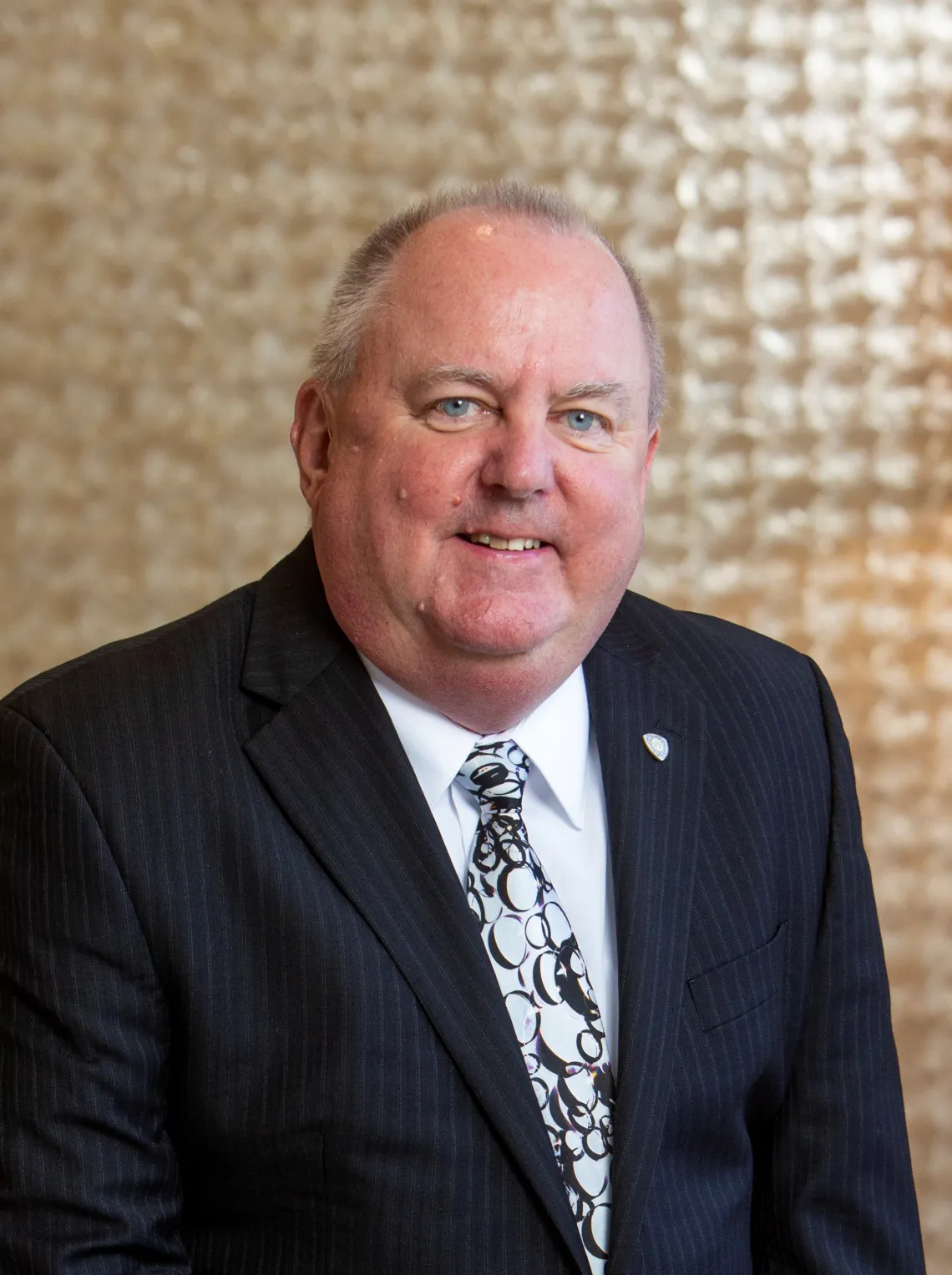
SPIE
I never teach my pupils; I only attempt to provide the conditions in which they can learn.
(Albert Einstein)
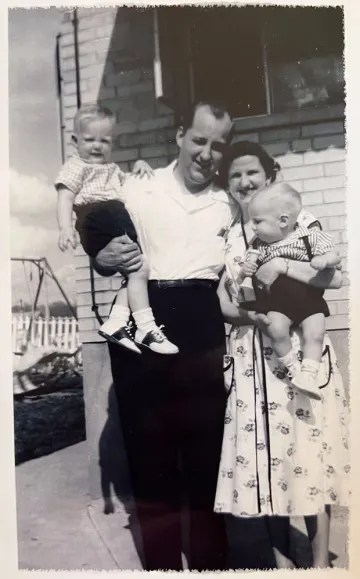
It was well-known that Professor John E. Greivenkamp Jr. was a great teacher, with incredible knowledge and enthusiasm for the subject matter he was presenting. But for John, the educational environment was not confined to the classroom but extended to his home, his community, and beyond. His teaching was at times informal and organic, flowing from the tasks at hand—touching the lives of many.
EARLY LIFE
Born 12 September 1954, to John (Jack) and Rita Greivenkamp, John and his five younger siblings—Michael, Gary, Gregg, Jill, and Ted—grew up in the suburbs of Cincinnati, Ohio. John’s father, a veteran of the Korean War, took advantage of his GI Bill benefits to earn both a bachelor’s and a master’s degree in Accounting from the University of Cincinnati. His passion for education instilled a love of learning in John.
After graduating with honors from Saint Xavier High School in 1972, John enrolled at Thomas More University in Crestview Hills, Kentucky—a short commute from Cincinnati which allowed him to live at home all four years. Majoring in both Physics and Mathematics, John was also a member of the Alpha Delta Gamma Fraternity, Rho Chapter—a fraternity based on the principles and traditions of the Catholic Church. John’s “Pledge Father” and high school friend, Paul Roth, fondly recalls John’s love for the people in his life. “I accept that John was intelligent, but when I am thinking of John, that’s not what comes to mind. We never talked about technical stuff—not mathematics, not science, not engineering. We would talk about family and friends.”
HEAD WEST, YOUNG MAN
In 1976, after receiving his B.A. degree in Physics and Mathematics, John headed to Arizona to begin his graduate studies at the Optical Sciences Center (OSC).
I was always an applied experimentalist and, at the time, lasers and holography were all the rage. So, optics it was, and the choices were the University of Rochester and the Optical Sciences Center. Growing up in Cincinnati, the climate seemed better in Tucson.
(Historical Lens: Graduate Stories, 2020)
Working with professors Bill Swindell and Harry Barrett, John’s Ph.D. research was focused on developing an analog optical computer for computed tomography. At that time, computing power was limited, and the group felt optics was the way to go.
During the research for his dissertation, “Incoherent Optical Processor for X-Ray Transaxial Tomograph,” John produced images with analog computing that were indistinguishable from those obtained by scanning the same films with a microdensitometer and reconstructing them digitally, a process that took many hours, compared to abut 2 minutes with the analog system.
(Harrison H. Barrett and Kyle J. Myers, “Image Science and image-Quality Research in the Optical Sciences Center”)
EASTMAN KODAK COMPANY

After completing his Ph.D. in 1980, John headed back to the cold weather, accepting a position in the Camera Technology Lab of Eastman Kodak Research Lab in Rochester, New York. In his position as an optical engineer, John designed optical systems, interacted with optics manufacturing groups, and performed phase-shifting interferometry analysis. As he started publishing and became more involved with the interferometry community, he began to have frequent interactions with OSC professor Jim Wyant at optics conferences and meetings.
In 1990, Jim—along with OSC Director, Bob Shannon, and Associate Director of Academic Affairs, Jack Gaskill—began to recruit John for an associate professor’s position. According to Jim, “[they] were looking for an optical engineer with strong research and teaching skills.” After persuading John—and John persuading his new wife, Kay—the newlywed couple packed up and moved to Arizona in January 1991.
 PROFESSOR GREIVENKAMP
PROFESSOR GREIVENKAMP
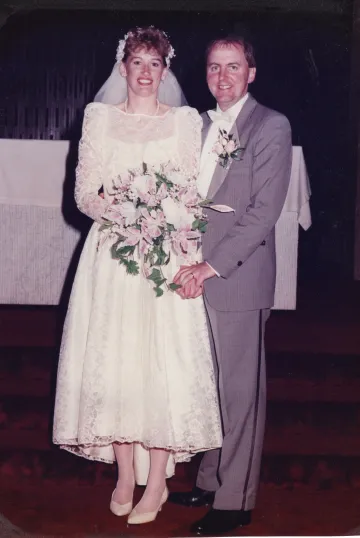
John returned to OSC as an associate professor of both Optical Sciences and Ophthalmology, soon becoming a full professor in 1997. He quickly found his footing as a respected teacher, renowned for his innovative teaching style that engaged and challenged students. John’s rigorous Geometrical Optics course—taught to both undergraduate and graduate students— became one of the cornerstones of OSC’s curriculum.
Over the next 30 years, John supported 41 M.S. and 20 Ph.D. students with his extensive research program in sub-Nyquist interferometry, conformal optics, ophthalmic optics, and contact lens metrology. John’s research with his students resulted in over 170 publications and presentations, garnering over 4,500 citations; a vibrant partnership with industry; and over 20 patents.
HARNESSING LIGHT
In 1994, the National Research Council (NRC) issued a report titled Atomic, Molecular, and Optical Science: An Investment in the Future. While the report found that optical science had become an integral part of a wide range of scientific disciplines, some aspects of optical science, and all of optical engineering, were beyond the scope of the report.
Consequently, early in 1995, John was asked to serve on NRC’s Committee on Optical Science and Engineering—individuals chosen for their diverse perspectives and technical expertise. The Committee was charged with surveying the field of optical science and engineering (OS&E); defining the technical scope of the field; identifying and prioritizing technical opportunities in context of national needs; and identifying institutional and educational innovations needed. Over the following year, Committee members participated in workshops to gather technical input from the OS&E community, then presented at public forums of several professional society meetings to inform the community about the study and solicit input.
The result, after three years, was a report titled Harnessing Light: Optical Science and Engineering for the 21st Century, heavily authored by John. Published in 1998 by the NRC, the report concluded that “the role of optics in research, which already cuts across nearly all fields of science and technology, will be limited only by our imagination, and colleges and universities will be challenged to meet the educational needs of a growing work force.” (National Academy Press, Washington, D.C.)
JOHNSON & JOHNSON PARTNERSHIP
Over the years, a lot of business relationships have been built over lunch. For John, one of the most important of his career took place at the 2001 Photonics West Conference in San Francisco, California, when he sat down for a discussion with Russell (Russ) Spaulding, then-Engineering Fellow in Optics for Johnson & Johnson (J&J).
John and his lab had a reputation for creative solutions to difficult optical testing applications, testing of conformal domes being a prime example. The ophthalmic world, both corrective devices and the human eye, presents its own unique testing challenges because of immersion of the devices in saline and safety restrictions with lasers in regard to the eye. At that meeting, John and I laid out a research strategy based on the priority of optical testing needs at Johnson & Johnson Vision Care.
Research began in earnest in March 2001 with the initiation of Greg Williby’s (then-John’s Ph.D. student) research into interferometric testing of contact lenses. The work was so successful, upon his graduation, Dr. Williby was brought to J&J to develop his technique into the instrumentation currently used for releasing billions of production lenses each year. The follow-on work in John’s lab saw the successful demonstration of a dual interferometer system to measure the index of refraction of immersed optical polymers to unprecedented levels.
With device testing under control, the lab turned its attention to optical characterizations of the human eye. A method of characterizing the higher order aberrations in the eye using a self-directed vision test was demonstrated. An interferometric technique was developed to characterize the evolution of a thin fluid film on a spherical surface. This technique was applied first to quantifying the wettability of a polymer surface, opening research in advanced materials, then was developed for characterizing the evolution of the human tear film on-eye, providing a valuable diagnostic approach to the “dry-eye” problem.
By 2003, and through the end of 2015, virtually all of John’s students’ research was directed to J&J’s ophthalmic optical challenges. Some of the projects were more successful than others, but all provided valuable insight.
This type of collaboration is rare and was immensely successful for both the corporation and the University and was summarized by John in a presentation on interferometry in ophthalmology at SPIE Optics + Photonics in 2014. All the success was primarily due to John’s background in industry, the professional and personal friendship we developed, and his strong dedication to his students’ futures.
(Russell Spaulding President, Optical Engineering Group)
Hence, it is very fitting that for a 2020 Historical Lens interview of OSC graduates, John gave this advice to that year’s graduating class, “Get involved in the professional societies. It is a commitment to your profession and a way to give back. You will meet and become friends with so many people that you would not have otherwise.”
FIELD GUIDE TO …
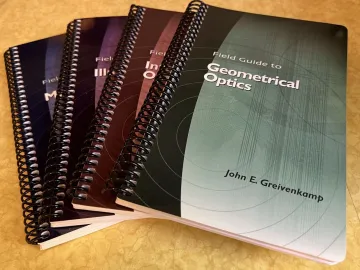
Around 2004, John was approached by SPIE and asked to serve as founding editor for a new series of “pocket references” for the practicing engineer or scientist. After authoring the first book in the series, Field Guide to Geometrical Optics, John continued as series editor until 2020. Each Field Guide addresses a major field of optical science and technology, and includes the key definitions, equations, illustrations, application examples, design considerations, methods, and tips needed in the lab and in the field.
Coming up on the 20th year of publishing Field Guides, the 50th Field Guide was just published at the end of 2021 and the series is nearing one million downloads from the SPIE Digital Library, with 50,000 copies sold in print. John’s first book is still the series benchmark.
John had an incredible gift for making complicated topics and concepts accessible to others and was always passionate about fundamentals. The Field Guide series was a perfect example—I don’t know anyone who doesn’t have his Geometrical Optics guide on their bookshelves.
Professor Jim Burge and I published the “Field Guide to Optomechanics” shortly after I graduated from OSC, and it has opened so many doors for me. I will always be grateful that John set that opportunity in motion.
(Katie Schwertz, M.S. 2010)
THE MUSEUM OF OPTICS
By day, John Greivenkamp is a professor of optical sciences at the University of Arizona. At night, he turns into the Indiana Jones of the Internet, searching for antique telescopes, binoculars, opera glasses, microscopes, cameras, and lenses for the UA’s newly dedicated Museum of Optics.
(Chesnick, Mike. “Bringing history into focus.” Visitor Guide: The University of Arizona, Fall/Winter 2011.)

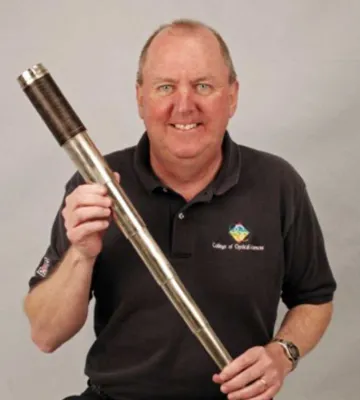
After teaching for over 10 years, John began to fear his students were in danger of losing the connection to their field’s beginnings. He often recounted the story of showing a student a 1960 Polaroid instant camera and, “instead of being wowed by the technological breakthrough that the Polaroid’s nearly instant images signified, the Digital Age student wondered why the old camera used flashbulbs instead of an electronic flash.” (Sorenson, Dan, 2008, March 27, “Old telescopes are windows to the past,” Arizona Daily Star.)
Starting in 2003, using John’s discretionary funds from teaching graduate distance learning courses, he and retired environmental engineer David Steed collected items through eBay auctions, antique deals and personal donations. One of John’s favorite finds was a silver Galilean monocular, a refracting telescope featuring a tooled silver and tortoise shell, made in 1280 by London’s John Dollond. John was always quick to point out that he “loved the thrill of the hunt and was pretty good at swooping in at the last minute for the acquisition.”
Pretty good, indeed, as the collection now holds more than 1,000 antique and historic pieces, dating from the 1600s. Displayed throughout the Meinel Building—and officially dedicated in 2011—the Museum of Optics is one of the major educational outreach programs of OSC and attracts many visitors each year to the College. Visitors can go through the museum to see the development of optics technology; to explore the changes in the materials used; or even to just appreciate the beauty and craftsmanship of these items.
PROFESSIONAL SOCIETIES

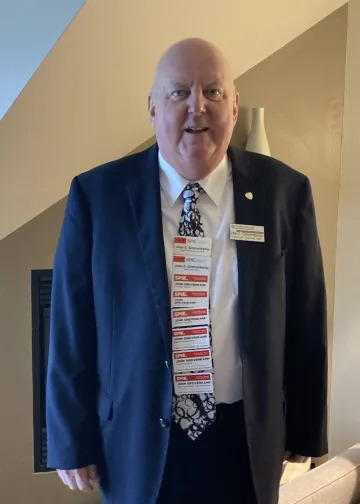
John’s dedication to Professional Societies, such as SPIE and Optica (formerly, OSA), was immense. With each new step of responsibility, John was happy to pass on guidance and encouragement from his extensive service history.
As an Optica Fellow and former member of the Optica Board of Directors, John held numerous positions during more that 30 years of membership, including Science and Engineering Council Chair, Executive Council member, and Ex-officio Director.
Prior to serving as SPIE President in 2020, John was elected Fellow in 1996 and served two terms on the Board of Directors. He also served on numerous SPIE committees, including Publications, Symposium, Education, Strategic Planning, Scholarship, and Awards. In 2017, he received the SPIE Maria J. Yzuel Educator Award for his dedication to both formal and informal optics education, his passion for transferring his knowledge to the next generation of engineers, and inspiring students of all descriptions to an appreciation of science.
On the second day of the Board Meeting in Bellingham this last November, John surprised us by adorning his tie with all the SPIE badges he has worn over the years. It was a sight nothing short of impressive and showed John’s long dedication to SPIE and his diversity of what he had contributed.
(Leonard Chen, Director of EOIR Sensor Technologies, Raytheon Technologies)
FAMILY
This Field Guide is dedicated to my wife, Kay, and my children Jake and Katie. They keep my life in focus (and mostly aberration free).
(John Greivenkamp, “Field Guide to Geometrical Optics”)
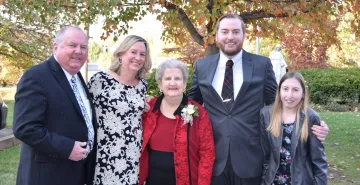
John's Family, (L to R): John, Kay, Rita, Jake and Katie
When John found out that he had cancer over thirteen years ago, in 2009, he decided he was not going to let cancer rule his life. He would schedule treatments around his schedule and would continue to live his life fully, which he did wholeheartedly.
John had a remarkable career and was highly regarded by students and colleagues, but that was only a part of John. He was a wonderful cook, wine connoisseur, collector, and photographer. He and Kay loved touring Europe, especially on river cruises, and visited many awe-inspiring places together. And his greatest achievement, according to John, was their children, Jake and Katie. Kay recently shared a couple of fond memories with me of John, Jake, and Katie.
John and Jake: Although John did reach the level of Life Scout as a Boy Scout when he was in high school, he was not much of a camper. However, when our son, Jake, was going up the ranks as a Boy Scout to become an Eagle Scout, John came out of his Marriott-comfort zone to go on some scout outings. On one of the early outings, John taught the young scouts some basic cooking skills and how to use a Dutch oven on the campfire.
On another more adventurous outing, John went with the troop to the Emerald Bay Scout Camp on Catalina Island for an entire week. As part of the swim safety protocols, everyone, including the adults, were required to take a swimming test in the ocean. This was probably the one and only test that John ever failed in his lifetime, as the cold Pacific Ocean water was a bit too much for him. John also found other ways to participate in Jake’s troop, serving as Committee Chairman for Troop 007 for several years.
Later, when Jake was in college, John and Jake took a week-long trip to the National Parks of Utah where John showcased his photography skills by taking some beautiful landscape photographs. But, on this trip, while they hiked during the day, they slept in hotels at night!
John and Katie: John loved to cook and did all the cooking for the family. He especially loved cooking the big meals on holidays—turkey on Thanksgiving, prime rib on Christmas, etc.
Katie graduated from college in May 2020, just as everything was shutting down due to COVID-19. So, she moved back home and lived with us until October 2021. Because we were all home (John was teaching from home), we got to spend more time together than we normally would have.
One of the things that brought John and Katie together during that time was cooking. John was always excited when Katie showed an interest in how to make something—she knew that eventually she would be out on her own and wanted to be able to prepare all her favorite dishes.
At Thanksgiving, one specific task always fell to Katie, and she loved doing it. John would make a huge batch of bread stuffing. He had specific quantities of different types of bread needed to make many casserole dishes of stuffing that we would eat throughout the year. Katie's job was to prepare the bread which consisted of drying out the bread the day before and, on Thanksgiving morning, tearing the bread into chunks into big bowls.
Katie learned all her cooking skills from John during this time, and we all enjoyed the fruits of their labor.
JOHN’S LEGACY
Light travels left to right. Light goes on.
Just as John’s father had instilled a love of learning in his children, John passed on his own love of learning to both Jake and Katie. Jake graduated from the University of Arizona in 2015 with a bachelor’s degree in Mechanical Engineering and an Optics minor. Katie received her master’s degree in Graphic Information Technology from Arizona State University in 2020. Additionally, John’s passion for optics inspired Jake to pursue a career as an opto-mechanical engineer. While currently employed at Raytheon in Tucson, Jake is completing a master’s degree in Optics at OSC.
In recognition of John’s profound dedication for teaching and the many ways he has enriched student lives, the John E. Greivenkamp Endowed Scholarship in Optical Sciences was established at the University of Arizona in 2012. This permanent fund supports undergraduate students as they pursue an education in optical sciences.
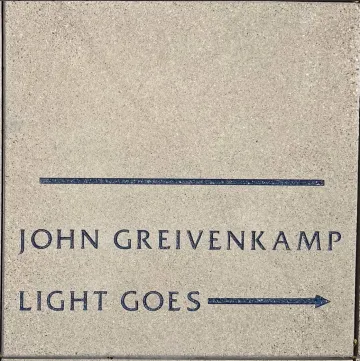
Memorial Tile, McKale Center, 2022
